|
|
EDITORIAL: Remembering the Gadar Heroes
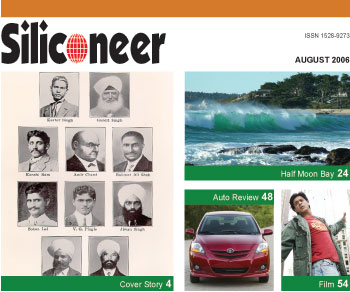 August is the month of celebrating India’s independence, and Indian Americans will join festivities all over the U.S. with great joy and enthusiasm. August is the month of celebrating India’s independence, and Indian Americans will join festivities all over the U.S. with great joy and enthusiasm.
The degree of self-satisfaction within the community is in danger of becoming a cliché — U.S. politicians gladly play second fiddle as they come and utter the usual bromides like strong family values and stress on education as they pocket the moolah in the frequent fundraisers.
It is easy to forget that this wasn’t always the case. The second wave of Indian immigration, that began in the middle of the last century brought a wave of smart, highly educated Indian students who flocked to U.S. colleges. Later many became distinguished academics, doctors and engineers who lived happily ever after in leafy suburbia.
Things were very different at the beginning of the 20th century. That was the time when racism was still rife, Indians and Chinese were considered a threat by local labor, and all kinds of laws—ranging from miscegeny laws to curbs on property ownership—put Indian immigrants at a serious disadvantage.
It was in those circumstances that a group of Indian expatriates got together and decided that one of the reasons for their misery in the U.S. was the fact that their home country, India, was still under British rule. So they decided to give up everything and go back to their homeland to fight for the freedom of the country.
These are the Gadar heroes, and we are pleased to offer a poignant historical essay on these patriots by folklorist and award-winning poet Ved Prakash Vatuk.
Cracking jokes about the rustic and colorful Lalu Prasad Yadav is a popular sport among India’s chattering classes. This proud cowherd from one of India’s more backward and lawless states has drawn contempt, or at best condescension as analysts have darkly alluded to his political shenanigans and alleged involvement in one of the biggest scams in India. The so-called fodder scam was a brilliant trick to rob the government: Millions of rupees were shown to be spent on fodder for nonexistent cattle as crooks happily pocketed the proceeds.
God, newspaper columnist Russell Baker once said, is a cosmic joke player. One can only wonder what all those snobbish pundits have to say now that all the world’s top management gurus are lining up to study the Bihar cowherd’s management techniques after what can only be called a staggering achievement.
Lalu Prasad Yadav, this rustic villager who takes enormous pride in his village roots, has done the impossible. He has turned around the Indian government’s biggest white elephant, the Indian Railways, and has turned it into a money-making operation.
Experts from the Harvard Business School as well as the Indian Institute of Management are now making a beeline as sheepish snobs in Delhi look the other way.
The world’s attention has been focused on the dreadful carnage in Lebanon unleashed by Israel following a kidnapping of its soldiers by the Lebanese Shiite resistance group Hizbollah.
The daily images of the gruesome murder of civilians on both sides of the border, but far more lethal in the case of Lebanon, makes one wonder with sorrow and bafflement: When will we ever learn. Whether it is the ancient battleground of Kurukshetra or the millions of corpses strewn around Somme in World War I, war is a horrible, barbaric way to resolve conflict and yet human civilization still seems not to be able to have weaned itself away from its deadly seduction.
Roshni Rustomji-Kerns has seen it all, sometimes from close quarters, as she witnessed the carnage in 1947 as a child, sometimes from afar, as she witnessed the war in Vietnam on television screen while in the U.S. She has fond memories of Lebanon as a student at the American University of Beirut, and she weaves all these experiences into a moving essay about the terrible trail of destruction and pain left by war and conflict.
Ravi Swamy offers a tough critique of India’s growing warmth with Israel, given Israel’s persistent oppressive policies against its Arab neighbors and particularly its egregious behavior towards the Palestinians, whose land it continues to occupy. While Swamy supports increased people-to-people contact between the two nations, he takes issue with the growing military ties and elite cooperation, which he says flies in the face of India’s longstanding and distinguished historic record of standing up against colonial oppression.
Do drop us a line with ideas and comments about how we can make Siliconeer better serve you.
|TOP|
COVER STORY:
Gadar Heroes: A Stirring Tale of Selfless Patriotism
Nineteen-year-old Kartar Singh Sarabha, while in his solitary cell waiting to be hanged, wrote in the walls with coal: “The blood of a martyr is never shed in vain.” Poet and folklorist Ved Prakash Vatuk pays tribute to these remarkable Indian expatriates who left the Pacific coast in the 20th century to fight the British in order to free India.
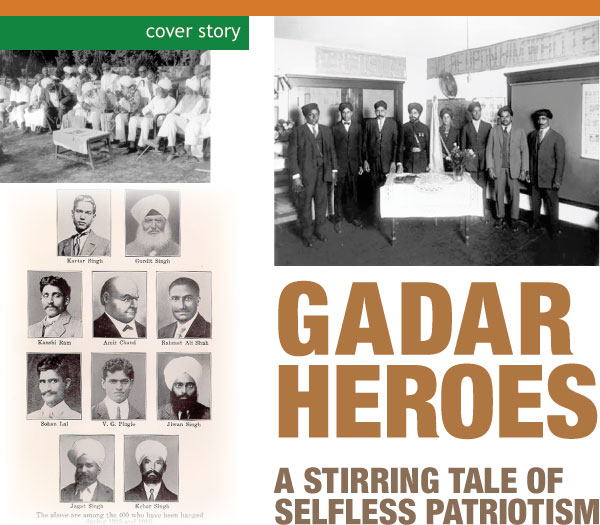
(Top left): 100th Birthday of Ghadri Baba Karam Singh Cheema, October 1966. (Sitting from right): Baba Kisham Singh Bundala, Baba Sohan Singh Bhakna, Baba Karam Singh Cheema, Baba Bhag Singh Canadian, Com. Har Kisham Singh Surjeet. (Standing behind from right): Pandit Kishori Lal, Gurcharan Singh Randhawa, Basu Pumia.
(Bottom left): Some of the 400 people who were hanged during 1915 and 1916. (Pic: T.S. Sibia/U.C. Davis)
(Top, right): A jatha, or group of freedom fighters, about to depart for India in San Francisco, 1924. The group was photographed at 5 Wood Street. (L-r): Genda Singh, Daswanda Singh Mann, Inder Singh, Mahendra Pratap, Shamsher Singh (Bud Dhillon), Bishan Singh Burj, Charan Singh Dhuleta, Dhula Singh.
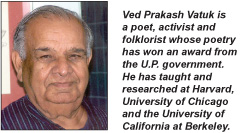 “… Give me your tired, your poor, Your huddled masses yearning to breathe free/ The wretched refuse of your teeming shore/ Send these homeless, tempest-lost to me/ I lift my lamp besides the golden door!” “… Give me your tired, your poor, Your huddled masses yearning to breathe free/ The wretched refuse of your teeming shore/ Send these homeless, tempest-lost to me/ I lift my lamp besides the golden door!”
So read the grand proclamation inscribed at the 305-feet high Statue of Liberty, which the American poet Emma Lazarus called the “Mother of Exiles.” The statue stands on Liberty Island, a 12-acre island in Upper New York Bay. It invited all those people without hope to the “Land of Liberty” and the “Home of the Brave.” On the other side of the continent the Chinese saw the Gold Mountain: America — the land of opportunity, where everyone was free to make his/her mark with hard work and could pursue the dream of happiness and prosperity.
And then again, some brave soldiers of the Indian Army, who came to England at the end of the nineteenth century to take part in the celebration of Queen Victoria’s 60th year of rule, were given a chance to see part of the British Empire situated on the other side of the earth — Canada, a country with an area many times larger than India with very little population. They liked the country and wanted to settle down there. After all, they were the citizens of the British Commonwealth and had every right to settle down anywhere in the empire as dedicated soldiers who were ready to sacrifice their lives for the preservation and expansion of that empire.
So they came. Traveling by foot or by cart from their villages to the nearest railway station, taking a long train journey to a sea port like Kolkata (then Calcutta), catching a ship to the shores of Southeast Asia and then again making a long voyage to San Francisco or Vancouver. They borrowed money, they mortgaged their property, and they sold their land. They had a small bundle of their meager belongings and grand dreams. They would work hard, make lots of money and return home.
But they did not know that the lofty proclamations were not for them — that the Statue of Liberty spoke only to the Europeans and whites. The constitution of the United States declared, “All men are created equal,” but not all were included. It did not include the Native Americans, whom the fathers of the framers of the constitution slaughtered and displaced to build their empire.
Nor did it include the African Americans who were brought in the new world as slaves to work their plantations. Clearly women were excluded. Even white people without property were not given the right to choose their representatives. Asian immigrants soon found that they were entering not the gates of heaven, but were facing a life of hell. Before they could enter the mainland, they were housed in Angel Island prison to rot.
“I was a citizen of China
But I decided not to remain that,
And on my own will
I became an ox
My intention was
To come to America
And earn a living
The mansions of the West
Are exalted and grand
But it was not my fortune
To reside in them
How could I have known
That I shall be housed
In a prison.”
Those who made it in the end soon found out that they were not very welcome in their new country. The thick wall of white supremacy stood between them and the rest of society. When, by the end of the first decade of the nineteenth century, the number of immigrants from India reached ten thousand, both Canada and the U.S. began to warn of the horrible consequences if this invasion of yellow and brown race was not stopped. The fear was that these rag-headed uncivilized people of peculiar habits not only could not assimilate in the grand white society, but they would tear the whole fabric of civilized society to shreds. America and Canada in those days were countries that were racist to the core. Blacks and whites could not reside in the same neighborhood, could not use the same water fountain, could not ride side by side in buses or trains, could not intermarry. Even to look at a white woman could bring death to a black.
As far as Indians were concerned, whose nation was reduced to such a miserable state by British rule that the only way for them to get out of their misery was either to join the army or go abroad, their situation became even worse. They could work in factories or in fields for wages lower than other workers. By doing so they became the enemy of the working class, who thought they were bringing the standard of living for other workers down. The rest of society despised them for what they were — Indians. They could not own land, they could not buy any property, they could not get married to a white woman and could not bring their wives or other female relatives to America. Many riots took place against them. Sometimes they were chased out of their houses at midnight by rioters. They were needed to build America’s railroads, bridges, to work in its lumber mills, to work in its farms, but they were not worthy of any privilege or respect. Laws were passed against their countrymen’s entry into Canada and the U.S. If they went back to India, they would not be allowed to return. It was these conditions that forced a writer to exclaim: “We foreigners have no home. We are just the coolies of the world.”
It is true that Chinese and Japanese workers at that time also had the same fate. But there is a big difference. The governments of China and Japan backed their citizens. They talked to the governments of Canada and the U.S. about the rights of their citizens. But the only government the Indians had was the oppressive British government which did not want them to learn anything about human rights, human dignity and freedom. In fact, they were imploring the governments of Canada and the U.S. to keep a sharp eye on these Indians, otherwise, they would be infected by the virus of freedom, which would be detrimental to peace in the British empire. The so-called Indian government sent its agents to spy on them and report to the governments of Canada and the U.S.
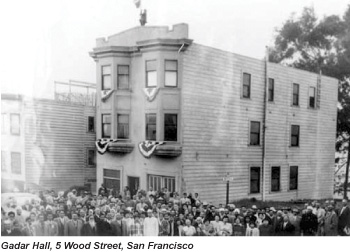 It is against this background that we should look at the history of the Gadar movement. The few intellectuals like Lala Hardayal, Taraknath Das and others, and students at the University of California at Berkeley, who looked at their plight theoretically, came to the conclusion that the plight of Indians in America was the result of the fact that they came from a “slave country,” a nation of 330 million people subjugated by an island of 40 million. It is against this background that we should look at the history of the Gadar movement. The few intellectuals like Lala Hardayal, Taraknath Das and others, and students at the University of California at Berkeley, who looked at their plight theoretically, came to the conclusion that the plight of Indians in America was the result of the fact that they came from a “slave country,” a nation of 330 million people subjugated by an island of 40 million.
They deserved to be treated like dirt. After all, Americans fought the British and became independent. Why can’t Indians do the same? As long as India remained a colony of white people, its citizens deserved no respect. What these intellectuals learned after reading lots of books, the illiterate and semi-literate workers learned by living and working in the fields and the factories.
Suddenly many of them — who were the products of the British Army — realized that they worked for the British empire to make it more powerful and thus reducing their own value to nothing. Suddenly they came to the conclusion that if Indians are to be treated like other respected human beings, they have to forget everything and begin working towards the goal of India’s freedom.
So one glorious morning in Astoria, Ore., they decided to establish an organization — Hindi Association of the Pacific Coast — and to launch a weekly called Gadar in several Indian languages. The headquarters of the party and paper was to be in San Francisco. It was named Yugantar Ashram. On November 1, 1913, the first issue of Gadar was launched in Urdu. It declared, “Today, there begins in a foreign land a war against the British Raj in our language.” The paper electrified the Indian community not only in the U.S., but everywhere in Asia and Latin America as well. It became so popular that people soon forgot the name of the of the organization and the name of its headquarters, which began to be called the Gadar Party and the Gadar Ashram. Money and volunteers began to pour in. The paper began to be published in Punjabi and other languages.
The Gadar Party and Gadar both declared that the aim of the movement was to attain “complete freedom for India” and “establish a democratic rule based on equality, economic and social justice.” It was a party of people who practiced what they preached. Its members lived together and all paid $2 a month. Intellectuals like Lala Hardyal, Maulana Barkatullah, activist young students like Kartar Singh Sarabha, Dalit worker (later founder of the Adi Dharma in Punjab) Mangoo Ram, workers, poets like Hari Singh Usman and party president Sohan Singh Bhakna, all sat and ate together. Many of the leaders of the party were very well-versed in theology and religion, even wrote extensively on spiritual matters like Bhai Bhagwan Singh. Pandit Jagat Ram and Maulana Barkatullah. But at Yugantar Ashram and in party work, religion was a subject never to be discussed. The job of the party was to prepare people for total dedication to fight for the independence of India. Gadar carried extensive exposes of the criminal deeds of the British empire, it carried poetry to inspire young and old. The first issue declared: “What is our name? Gadar. What is our work? Gadar. Where will it be? In India. When? Soon. The time will soon come when rifles and blood will take place of pen and ink.”
Occasionally Gadar carried an advertisement. It read: “Wanted: Enthusiastic Heroes to Organize Gadar in India. Pay: Death. Reward: Martyrdom. Pension: Freedom. Field of Work: India.” The poems in Gadar glorified the past of the nation, described its present plight and readers inspired to have a dream for the heavenly future. Making that future a reality would need sacrifice from each Indian. Total sacrifice — the body, the mind and the wealth.
They knew the path was not easy. Kartar Singh Sarabha used to sing while working on the paper, “It is so hard to serve one’s country/ Talk is so cheap/ Those who put their foot forward in the path of service/ Have to face thousands of hardships.”
The British government was so alarmed by the publication of Gadar that it pressured the American government to force Hardyal to leave the U.S. But Hardyal’s removal from the scene only brought more determination to Indians. They were transformed. No more destitution — it was all enthusiasm for the revolution, just waiting for the proper time.
They thought it came when World War I was declared. The party called on its workers: “Our enemy is trapped. Let us go home and fight.” And they did. Thousands of them left their property behind. From all over the world they came. To organize the people. To infiltrate the troops, to ask them to fight not for the empire but for the country. Their fight was not for themselves. It was for the common man and the nation as a whole.
But the country was not ready. All political parties were supporting the war efforts. Punjab, from where ninety percent of them came and the Sikh community to which ninety percent of them belonged, were the most supportive of recruitment efforts. The Gadar movement could not become a mass movement. Also, the British government knew practically everything they conceived. It had planted spies among them. They betrayed their date of actions. Most of them were arrested as soon as they set foot on Indian soil. Still, persons like Sarabha and Vishnu Ganesh Pingle kept working, going from village to village, going from army barracks to army barracks, trying to unite revolutionaries from Bengal to Maharashtra. Finally, they too were betrayed. The war against the emperor never materialized. They were arrested before the planned mutiny could take place, tried and sentenced.
Gadar was truly a people’s movement. It consisted of people from all walks of life with equal contribution. Its outlook was global. Work for the freedom of the country where you were living. Work for the masses. It was a completely secular movement. Unity was its strength. Equality was its goal along with social and economic justice.
Did the Gadar movement fail? In spite of the fact that several revolts almost took place in the army in British India, in Burma (now Myanmar) and other places, the fact remains that these plots were discovered in advance. Hundreds of soldiers were disarmed and punished severely. So one can say in the end not much was achieved.
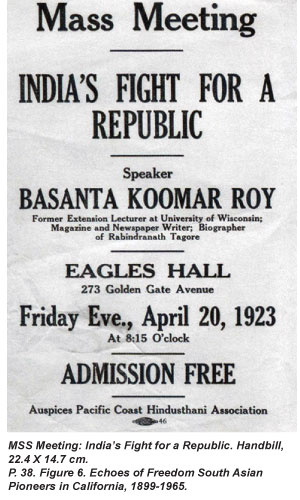 But did the Gadar movement really fail? Did the non-cooperation movement fail? Did the movement led by the revolutionaries like Bismil and Bhagat Singh fail? But did the Gadar movement really fail? Did the non-cooperation movement fail? Did the movement led by the revolutionaries like Bismil and Bhagat Singh fail?
Technically they all failed. After all, not many British were killed in all those movements and so many martyrs sacrificed their lives. But martyr after martyr, they all joyfully said that their sacrifice is like watering the orchard of freedom, where a crop of patriots would flourish. When the youngest and the most enthusiastic martyr, 19-year-old Kartar Singh Sarabha, was held in his solitary cell waiting to be hanged, he wrote in the walls with coal: “The blood of a martyr is never shed in vain.” All these so-called failed movements brought freedom a step closer. A battle was lost each time, so it would seem, but the war was about to be won. Each failed movement gave birth to a more dedicated movement.
The hanging of Sarabha gave us Bhagat Singh. But the main thing is that after leaving everything behind, the Gadar heroes never looked back in regret. They survived all the atrocities that a cruel government could mete out and came out with deeper dedication. Years of imprisonment in Andaman and Nicobar’s horror prison did not break them. Their spirit was never down. And that is their victory and ours.
Many of them saw India become free. But their dream remained unfulfilled. Sohan Singh Bhakna lamented that he could not be happy when millions still go hungry, when workers are still being exploited, when injustice prevails on every level of society, when equality still remains a dream, and exploitation remains the norm of the day, the divide between haves and have-nots keeps getting wider and wider. Not only that, during his speech to commemorate the 120th year anniversary of the first war of independence (May 10, 1977) one of the most daring Gadar heroes, Prithvi Singh Azad, lamented that people don’t even remember the sacrifices of all these selfless, brave people.
But then, each generation has to have its own Gadar heroes, its own gadar. Kartar Singh Sarabha wrote: “Our struggle will continue as long as a handful of men, be they foreign or native, or both in collaboration of each other, continue to exploit the labor and resources of our people. Nothing shall deter us from this path.” In fact, as long as even one person goes hungry on this earth, as long as one nation remains slave or occupied by any other country, as long as one group is discriminated against in day-to-day life, the spirit of Gadar remains unfulfilled.
|TOP|
SUBCONTINENT:
Harvard Goes to Lalu: Politician Reforms Railways
The desi snobs have egg all over their face as management experts from as far as Harvard come to study Railways Minister Lalu Prasad Yadav’s magic management style that has brought a stunning turnaround in India’s mammoth loss-making enterprise, writes Siddharth Srivastava.
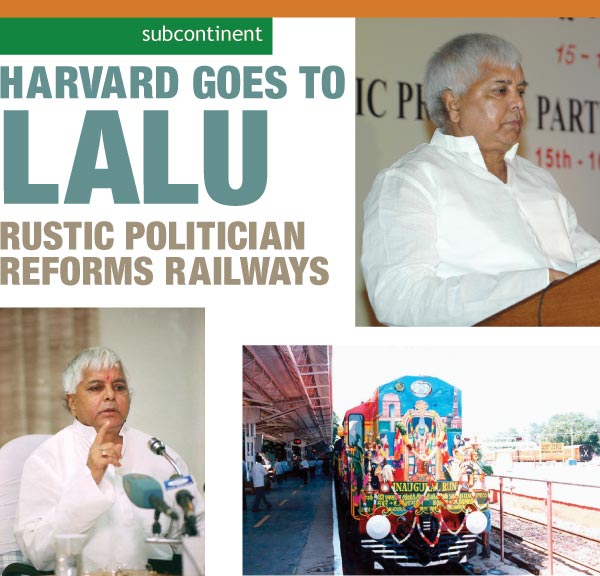
(Clockwise from top): Union Minister for Railways Lalu Prasad speaking at the inauguration of the Public-Private Partnership Convention on Indian Railways in New Delhi in June; Lalu Prasad flagged off the newly introduced Madurai - Hazarat Nizamuddin Tamil Nadu Sampark Kranti Express at Madurai in Tamil Nadu. Union Minister for Railways Lalu Prasad addressing the media to announce a policy matter in New Delhi.
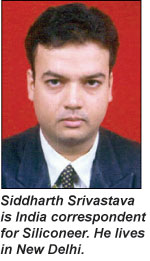 He may be referred to as a joker politician, some analysts may darkly speculate about his propensity towards corruption and nepotism, but Railway Minister Lalu Prasad Yadav also packs a lot of business sense. Don’t take our word for it. Some of the top management institutes such as Harvard Business School, HEC Management School, France and the prestigious Indian Institutes of Management think so. They have deemed his efforts as minister as fit for a case study by upcoming global managers.
He may be referred to as a joker politician, some analysts may darkly speculate about his propensity towards corruption and nepotism, but Railway Minister Lalu Prasad Yadav also packs a lot of business sense. Don’t take our word for it. Some of the top management institutes such as Harvard Business School, HEC Management School, France and the prestigious Indian Institutes of Management think so. They have deemed his efforts as minister as fit for a case study by upcoming global managers.
This comes in the wake of a remarkable turnaround of the Indian Railways attributed to the maverick Lalu. After being on the brink of a debt trap, the world’s second largest rail network has close to $2.5 billion in fund balances (over $3 billion in internal resources), from $78 million in 2001 and has announced huge plans to invite investments, from within and outside, to ramp up a creaking infrastructure. Five years ago, a government committee wrote off Indian Railways, saying it was hurtling towards a terminal debt trap. Lalu has said the turnaround was achieved by changing the old dictum — hiking goods and passenger fares to minimizing cost.
Both Harvard and HEC France have shown interest in turning Lalu’s experiment with the railways into case studies for aspiring business graduates.
“We are looking at making the Indian Railways a part of our course. While nothing has been finalized as of now, I will be visiting India in October-November to talk to the concerned officials,” said Karine Lejoly of HEC.
The Times of India reports that Prof. Steven R Ditmeyer, a former faculty member of Harvard and now on deputation to the National Defense University, will also be visiting India later this year to study the railways model. Incidentally, Lalu is already a subject of a study by sociologists at Harvard University in the United States.
A senior official of the Indian Railways said: “The professor is intrigued by the man behind the success story of the railways and will be visiting India soon to learn more about him as well as the turnaround. His subject of the case study would be — How has a man with no formal education brought about a change of this magnitude? On basis of his view, Harvard Business School will consider a case study on the railways.”
Lalu himself is quite unfazed by such international attention and has said: “People all over the world want to know how the son of a cowherd has risen to such heights. Their interest in me is a victory of Indian democracy.”
The prestigious IIM-Ahmedabad has already introduced Lalu in their curriculum. According to Prof. G. Raghuraman from IIM-A: “We are not just working on the facelift that Lalu has given to the railways but also his personality, the team he works with and the initiatives he has taken. It was not as if Lalu applied some new principles, he was just the guy who said, ‘Let’s get down to it.’”
Indeed, it has taken some dexterous moves by Lalu to bring about the rail turnaround that has invited a pat on the back from none other than Prime Minister Manmohan Singh. Lalu has invited private-public partnerships and despite petroleum prices increasing, slashed fares, reducing air-conditioned upper-class categories from 18 percent to 10 percent, to also take on the budget airlines that have mushroomed.
The Rail Ministry has presented to the government a humongous plan to “transform Indian Rail forever” — a $100 billion plan for 2007-2012, up eight times from the meager $12 billion. Of this, $ 25 billion will be raised internally and through market borrowings and $40 billion from public-private partnerships.
Following the investment opportunities, the Indian Railways is being studied by some of the biggest global asset managers, investment bankers and consultants: UBS, Goldman Sachs, Deutsche Bank, McKinsey & Co and Credit Agricole’s CLSA.
Not too long back Lalu was considered a typical product of all that was wrong with Indian politics: where ideology rather than governance ruled supreme; where symbolism and not development can be the key to political survival; where visions of hope rather than substance reign; where caste and religion rather than performance are the criteria of an electoral base. With his performance as railway minister Lalu has upended all these assumptions.
But then that’s Lalu all over again. He’s the ultimate maverick in Indian politics.
|TOP|
NEWS DIARY: Roundup
 Landmark Case | A Voice of Reason, Intellect, Muslims and Pakistanis | Bureaucrat Honored | South Asian Heart Center Opens | House Okays Nuke Deal | Hindi Classes in New Jersey High Schools | Sikh Stabbed in Hate Crime | Rajender Reddy Health Center at UC Merced | Pew Scholar | Moonda Murder Landmark Case | A Voice of Reason, Intellect, Muslims and Pakistanis | Bureaucrat Honored | South Asian Heart Center Opens | House Okays Nuke Deal | Hindi Classes in New Jersey High Schools | Sikh Stabbed in Hate Crime | Rajender Reddy Health Center at UC Merced | Pew Scholar | Moonda Murder
Landmark Case
 An Indian American lawyer has won a landmark victory after the U.S. Supreme Court struck down the military commissions President Bush established to try suspected members of al-Qaida. The ruling, seen as a blow to the administration, came in Hamdan v. Rumsfeld, a case brought to the court by Georgetown law professor Neal Katyal for his client, Salim Ahmed Hamdan, a former aide to Osama bin Laden. An Indian American lawyer has won a landmark victory after the U.S. Supreme Court struck down the military commissions President Bush established to try suspected members of al-Qaida. The ruling, seen as a blow to the administration, came in Hamdan v. Rumsfeld, a case brought to the court by Georgetown law professor Neal Katyal for his client, Salim Ahmed Hamdan, a former aide to Osama bin Laden.
A five-justice majority ruled that the commissions, outlined by Bush in a military order on Nov. 13, 2001, were neither authorized by law nor required by necessity, and ran contrary to the Geneva Conventions.
As a result, no military commission can try Hamdan or anyone else, unless the president does one of two things: operate the commissions by the rules of military courts-martial, or ask Congress for specific permission to proceed differently.
Katyal, who had recently been named one of the nation’s “top 40 lawyers under 40,”has apolitical roots. His parents, immigrants from Punjab, were a doctor and an engineer. He became interested in law and politics when his father lost his job unjustly.
A former law clerk of U.S. Supreme Court Justice Stephen G. Breyer, Katyal’s career has had a dizzying trajectory. The Yale Law graduate went on to serve as national security adviser to the deputy attorney general and was commissioned by President Bill Clinton in 1999 to co-author a report on ways the legal profession can enhance its pro bono activities and diversify the bar. Katyal also served as co-counsel to Vice President Al Gore in the United States Supreme Court case of Bush v. Palm Beach Canvassing Board in 2000.
|Back to NEWS Diary| |TOP|
A Voice of Reason, Intellect, Muslims and Pakistanis
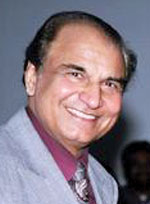 One of the leading voices of reason, intellect, Muslims and Pakistanis here in the San Francisco Bay Area, Professor Syed Hasan Jahangir Hamdani passed away July 28. His funeral was held the following day at the Rolling Hills Cemetery, 4100 Hilltop Drive in El Sobrante. Professor Hamdani was 66 years of age. He had been hospitalized for several days, and reportedly died of heart and lung problems and kidney failure. One of the leading voices of reason, intellect, Muslims and Pakistanis here in the San Francisco Bay Area, Professor Syed Hasan Jahangir Hamdani passed away July 28. His funeral was held the following day at the Rolling Hills Cemetery, 4100 Hilltop Drive in El Sobrante. Professor Hamdani was 66 years of age. He had been hospitalized for several days, and reportedly died of heart and lung problems and kidney failure.
During his many years of service to our Pakistani and Muslim-American community in California, Professor Hamdani touched several aspects of our lives in his own unique way. He was a speaker at what seemed like an infinite number of our cultural, political and religious gatherings during the past 25 years. His oratory skills, depth of analysis and affection for the people around him will be long remembered.
Professor Hamdani possessed excellent linguistic diversity and we often lost count of the languages that he spoke. He had a great grasp of Muslim and South Asian history and was considered a local authority on the Urdu language and some of its writers. His own poetry in Urdu was widely appreciated and we will certainly miss his presence at local mushairas and programs which he contributed to with the passion of a poet.
Hamdani Sahib had many interests. He spoke at India-Pakistan peace rallies, Muslim gatherings, Sikh events, Urdu language promotion programs and Pakistan Independence Day functions in northern California, to the delight of many. And he spoke from a scholarly authority which many of us had a chance to learn from. Pakistan Link reports covered some of these events.
As mentioned above, Hamdani Sahib’s range of interests covered a great deal. But beyond that he was a fine gentleman whom we will always remember for his cultured demeanor. Hamdani Sahib and some of us had politically opposite viewpoints. And even though we disagreed and were vocal about our differences, we never could turn down an invitation by him to the Hamdani family’s annual Naat Competition gathering to celebrate the prophet’s birthday. He could make his point, strongly disagree with someone and then shake his hand. We could all learn a great deal from his example.
An obituary is often unfair while attempting to squeeze a short description of a person’s rich and accomplished life, into a few sentences. That is very much the case here. And since we must now leave to others to write their own remembrance of Hamdani Sahib’s life, let us end by expressing our deep sadness to Mrs. Sohab Maqbool Hamdani, the Hamdani children and his siblings. This is indeed a great loss for not only them but our entire community. Inna Lillahe Wa Inna Alaihe Rajeoon
— Ras. H. Siddiqui.
|Back to NEWS Diary| |TOP|
Bureaucrat Honored
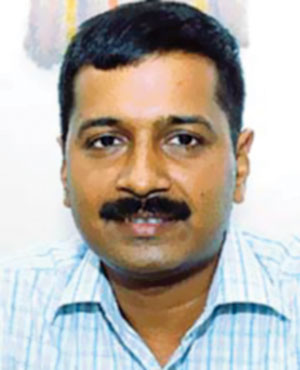 Delhi-based Arvind Kejriwal, a civil servant who has spearheaded the national campaign for the right to information, has been conferred the Ramon Magsaysay Award, the Asian equivalent of the Nobel Prize. Delhi-based Arvind Kejriwal, a civil servant who has spearheaded the national campaign for the right to information, has been conferred the Ramon Magsaysay Award, the Asian equivalent of the Nobel Prize.
Nepal’s Sanduk Ruit, 54, head of the Tilganga Eye Center, won the award for peace and international understanding for “placing Nepal at the forefront of developing safe, effective and economical procedures for cataract surgery, enabling the needlessly blind in even the poorest countries to see again.”
The annual awards, named after late Philippine President Ramon Magsaysay, will be presented to six recipients at a ceremony in Manila on Aug. 31.
In naming Kejriwal, 38, for the Magsaysay Award for Emergent Leadership, the board of trustees recognized his activating India’s right-to-information movement at the grassroots, empowering New Delhi’s poorest citizens to fight corruption by holding government accountable to the people, the organizers said in a citation.
“The brazen corruption of the high and the mighty may grab headlines, but for ordinary people it is the ubiquity of everyday corruption that weighs heaviest. And that demoralizes. Arvind Kejriwal, founder of India’s Parivartan, understands this, which is why his campaign for change begins with the small things,” the organizers said.
Kejriwal is an alumnus of the Indian Institute of Technology in Kharagpur and has led Parivartan, a citizen’s movement for the right to information.
A mechanical engineer, Kejriwal joined the civil services and was posted in the Indian Revenue Service in 1992. He is on leave from the government for the past two years.
|Back to NEWS Diary| |TOP|
South Asian Heart Center Opens
 The first nonprofit center in the world devoted to the prevention of coronary artery disease in people of South Asian descent, the South Asian Heart Center, opened at El Camino Hospital in Mountain View, Calif., July 12. The first nonprofit center in the world devoted to the prevention of coronary artery disease in people of South Asian descent, the South Asian Heart Center, opened at El Camino Hospital in Mountain View, Calif., July 12.
The unique center is designed to address the epidemic of heart disease among people from India, Bangladesh, Pakistan, Nepal and Sri Lanka, who are four times more likely to suffer a heart attack, at younger ages, without prior symptoms or warning, and without presenting the same risk factors as the general population. Through creating greater awareness, the center hopes to change the way physicians screen South Asian patients for heart disease.
More than half of heart attacks among South Asians occur before age 50, compared to an average age of 65.8 for the general male population, and 70.4 for the female population. In California, South Asians have four times the hospitalization rate compared to Caucasians and other Asian populations. The higher rates of heart disease in this group apply across the population, even for lifelong vegetarians who exercise regularly, do not smoke and are not overweight. This global epidemic affects both male and female South Asians living in the United States (including 350,000 who reside in the Bay Area), urban South Asia and elsewhere.
The center has a medical director and a council of physicians. The person who actually sees an incoming patient is a nurse practitioner and she does all the assessments. Each week the center’s medical director goes over all the results and comes up with a risk assessment.
A council of physicians, a panel of distinguished cardiologists, looks at the special or unusual cases. The center’s other goal is to educate physicians with regular symposia.
More information is available at www.southasianheartcenter.org
|Back to NEWS Diary| |TOP|
House Okays Nuke Deal
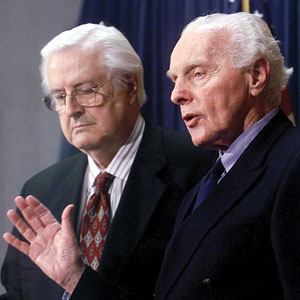 The U.S. House of Representatives has passed landmark legislation, approving the U.S.-India nuclear agreement by a massive 359-68 margin, rejecting several “killer” amendments on the way. The U.S. House of Representatives has passed landmark legislation, approving the U.S.-India nuclear agreement by a massive 359-68 margin, rejecting several “killer” amendments on the way.
The House vote was largely bipartisan with backing from both sides of the aisle: 218 Republicans and 141 Democrats supported the deal; only nine Republicans and 59 Democrats opposed.
En route to the historic vote, the House rejected at least three “killer” amendments that supporters said would have scuttled the agreement. An amendment that would have the U.S. audit India’s fissile material stock annually was rejected by a 155-268 margin. Another that sought to restrict uranium exports to India until the president certified that New Delhi had frozen its fissile material production was rejected 184-241.
A third one tried to link the deal to India further supporting the U.S. in its campaign against Iran. That was defeated 192-235 by supporters who argued that New Delhi had already proved its credentials as a U.S. partner opposed to nuclear proliferation in the Iran context.
About the only significant amendment that was passed without contest was one that enjoins the United States to support only India’s civilian nuclear program, and not its weapons program.
At the end of almost five hours of marathon arguments and legislative procedures, the United States and India Nuclear Cooperation Promotion Act of 2006, to be renamed the Hyde Amendment after the lawmaker who engineered it, was passed by a handsome 359-68 margin.
“This is a significant development in the implementation process. The numbers are very encouraging,” said strategic affairs analyst C. Uday Bhaskar. But “this is not a done deal,” he added.
The House of Representatives vote was part of a drawn-out legislative process to ratify the deal, which also has to be cleared by the Nuclear Suppliers Group, a group of nations that export nuclear material.
The act, when passed by the Senate, will permit a certifiably nuclear-armed India to buy reactors and fuel from the international market for the first time in more than 30 years, subject to final approval and international consent, despite the fact it has still not signed the Nuclear Non-Proliferation Treaty. It will in effect mark the end of India’s nuclear isolation and possibly rearrange the global strategic architecture.
|Back to NEWS Diary| |TOP|
Hindi Classes in New Jersey High Schools
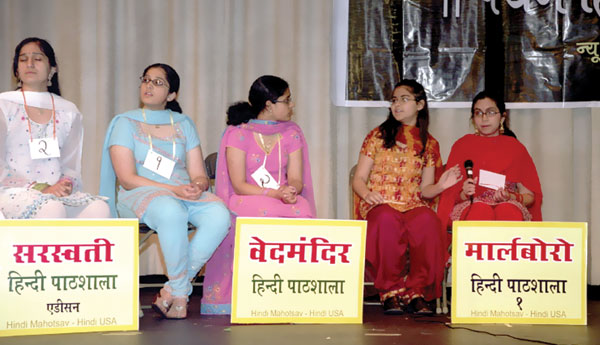
Following demand from the local Indian American population as well as a push from the Hindi language organization HindiUSA, two New Jersey school districts have applied for a federal grant that would enable them to teach Hindi in high school classrooms.
Edison Township and West Windsor-Plainsboro school districts in New Jersey will join Bellaire High School, a magnet school in Houston, Texas, in offering its students courses in Hindi.
Edison school officials have been considering adding Hindi and Chinese to their curriculum for nearly a year now.
If all goes according to plan, New Jersey high school students will be able to take classes in September 2007.
Thousands of parents, students and educators have signed an online petition in the last year asking U.S. school boards to add Hindi as an elective to their schools’ curriculum.
“Hindi will help bring us and our kids closer to India as well as help the United States to better understand and utilize the cultural and economic opportunities in Bharat,” reads the petition, which adds that similar efforts by members of the local Chinese community resulted in Chinese being taught in more U.S. schools.
Petition organizers — representatives from HindiUSA, a New Jersey-based organization that runs weekend Hindi schools — have also taken their cause offline. Representatives have met with school board members in West Windsor, where a large number of Asian Indians reside, to urge officials to offer Hindi by 2007. Other area towns with a sizable Asian-Indian population — Edison and South Brunswick — would then, ideally, follow suit, said Devendra Singh, coordinator of HindiUSA.
“Our main goal is to put Hindi as an elective language in high schools,” said Singh, who added that Hindi instruction is crucial for the large number of students of Indian origin living here and also because of the growing economic ties between the United States and India.
“This is not just for Indian students,” Singh said, “it’s for everyone.”
|Back to NEWS Diary| |TOP|
Sikh Stabbed in Hate Crime
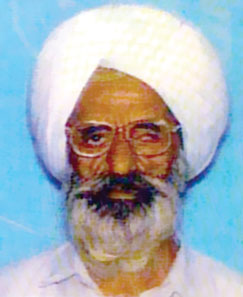 A 66-year-old Santa Clara, Calif., Sikh man was the victim of a July 30 stabbing that authorities allege was a hate crime. Iqbal Singh was standing with his two-year-old granddaughter in his family’s carport in, waiting to go to a religious service at the San Jose Gurdwara, when he was stabbed once in the neck with a steak knife. Everett Thompson, the 25-year-old assailant, was a neighbor who said in police interviews that he stabbed Singh because he wanted to kill a Taliban. A 66-year-old Santa Clara, Calif., Sikh man was the victim of a July 30 stabbing that authorities allege was a hate crime. Iqbal Singh was standing with his two-year-old granddaughter in his family’s carport in, waiting to go to a religious service at the San Jose Gurdwara, when he was stabbed once in the neck with a steak knife. Everett Thompson, the 25-year-old assailant, was a neighbor who said in police interviews that he stabbed Singh because he wanted to kill a Taliban.
According to family members, they did not know Thompson, and when he walked close, when Iqbal Singh asked what the matter was, Thompson stabbed him.
Singh then ran toward his family’s apartment building with Thompson in pursuit. At the same time, the rest of the Singh family, including Iqbal Singh’s son and daughter-in-law, emerged from the apartment. Thompson fled the scene when he caught sight of them.
Thompson was arrested at his home shortly thereafter, where police also found the weapon he used.
Thompson is being held in custody without bail. If convicted of the attack, he could face a sentence of life in prison.
At press time, Iqbal Singh was in stable condition at a local hospital. His granddaughter was unhurt. Bay Area South Asians, and Sikhs in particular, have expressed horror and fear over the recent spate of violence. Sikhs, whose traditional turbans are vaguely similar to those worn by the Muslim Taliban, are frequently the targets in these hate crimes. According to the Sikh Coalition, at least two Bay Area Sikh cab drivers have been shot to death since Sept. 11, 2001, and another was severely beaten. In 2004, bullets struck the entry sign for a Solano County gurdwara and in 2001, a 3-year-old Sikh boy was hit by a Molotov cocktail hurled through the window of his home.
|Back to NEWS Diary| |TOP|
Rajender Reddy Health Center at UC Merced
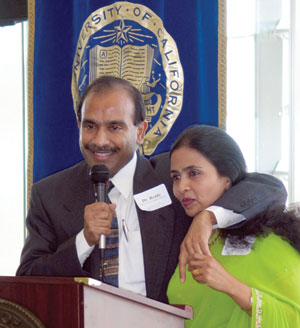 The health center at the University of California at Merced will be named Rajender Reddy Health Center after the cardiologist who donated $1 million to the project, university officials announced. The health center at the University of California at Merced will be named Rajender Reddy Health Center after the cardiologist who donated $1 million to the project, university officials announced.
The gift from Dr. Rajender Reddy and his wife, Jhansi Reddy, will allow UC Merced to focus not only on providing basic health care for its students, but also on health education, preventive services and general wellness, vice chancellor of student affairs Jane Lawrence said.
The health center will offer around-the-clock nurse advising, urgent and primary care services, immunizations and a pharmacy. It also will provide nutrition information, contraception, smoking cessation assistance, substance abuse counseling and stress management. The center is scheduled to open in October.
“One of the principles that we want to stress for our students is to have a developed sense of physical and psychological well-being,” Lawrence said. “We want to make that a distinctive feature of UC Merced.”
The 4,000-square-foot center is set to open in October. It will occupy the second floor of the Joseph E. Gallo Recreation and Wellness Center.
Reddy, who was raised in India and once worked as a farmer, launched his Hanford cardiology practice in 1989. He said he plans to continue to support the university and hopes to donate to UC Merced’s proposed medical school.
“In Hanford, we are having a very hard time finding enough doctors. We will support anything that will train more doctors to serve the people of the valley,” he said.
Jhansi Reddy’s uncle, Hanimireddy Lakireddy, has also made large donations to UC Merced, including a $1 million naming gift for the campus’ Lakireddy Auditorium.
|Back to NEWS Diary| |TOP|
Pew Scholar
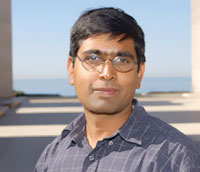 A biomedical researcher from the Salk Institute has been named a Pew scholar and will receive over $240,000 over four years for a research project at the University of California at San Francisco. A biomedical researcher from the Salk Institute has been named a Pew scholar and will receive over $240,000 over four years for a research project at the University of California at San Francisco.
Satchidananda Panda, of San Diego, was among 15 promising early- to mid-career biomedical researchers who won the prestigious grant awarded jointly by the Pew Charitable Trusts and the UCSF.
Panda is an assistant professor at the Salk Institute’s Regulatory Biology Laboratory. His research has focused on the biological clock, or circadian oscillator, that coordinates behavior and physiology with the natural light-dark cycle.
Panda received his bachelor’s degree from the Orissa University of Agriculture and Technology, and a Ph.D. degree from the Scripps Research Institute in La Jolla, Calif. He has done postdoctoral research at the Genomics Institute of the Novartis Research Foundation in San Diego.
The Pew/UCSF program allows researchers the flexibility to choose their research agenda and encourages them to become entrepreneurs by taking calculated risks and following unanticipated leads to maximize the benefits their research brings to society, the Pew trust said in a statement.
“For more than 20 years, the Pew scholars have demonstrated that great advances in our understanding of human health can occur when creative and talented individuals are given the opportunity to take risks,” said Rebecca W. Rimel, president and chief executive officer of the Pew Charitable Trusts. “Since beginning this program, we have found that investing in the ideas of the nation’s most brilliant scientific minds reaps tremendous returns for society, both from their scientific discoveries and as leading advocates for high-quality research.”
This year’s scholars plan to explore a variety of issues including the role of specific proteins in promoting memory and learning.
“This year’s scholars, like their predecessors, are pushing the scientific frontiers with imagination and discipline,” said Dr. Torsten N. Wiesel, chairman of the Pew Scholars Advisory Committee and a 1981 Nobel Prize laureate in medicine. “Who knows what benefit our children and grandchildren will reap from the work of a scholar, which speaks to the power of this investment.”
Since 1985, the trusts has invested more than $100 million to fund nearly 400 scholars.
Previous scholars have gone on to win the Nobel Prize in chemistry, the MacArthur Award and the Albert Lasker Medical Research Award.
|Back to NEWS Diary| |TOP|
Moonda Murder
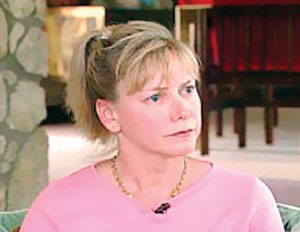 The details read like a juicy romance novel: A wealthy physician is said by authorities to have been killed by the other man — a handsome, young lover who’d been in and out of trouble. The details read like a juicy romance novel: A wealthy physician is said by authorities to have been killed by the other man — a handsome, young lover who’d been in and out of trouble.
The killing purportedly caps a highway robbery staged by the adulterous couple, who prosecutors say dreamed of getting their hands on the doctor’s millions.
That’s the torrid tale, at least, told in a federal affidavit released July 24 in the latest twist in the case of a Pennsylvania urologist killed last year along the Ohio Turnpike.
Donna Moonda, 47, of Hermitage, Pennsylvania, was charged on July 24 in federal court with interstate stalking that resulted in the death of her husband, Dr. Gulam Moonda. She also was charged with using a firearm in a violent crime.
Earlier, Damian Bradford, 25, of Monaca, Pa., near Pittsburgh, admitted in an Akron court to the same stalking charge leveled against Moonda and agreed to cooperate with authorities.
“He’s doing the right thing in his mind to step up to the plate,” said Michael DeRiso, Bradford’s attorney.
Gulam Moonda, 69, was shot May 13, 2005, when he pulled off the turnpike south of Cleveland to allow his wife to drive their car, authorities said. His wife said a gunman emerged from another vehicle, shot and robbed her husband and fled.
Federal court documents filed claim Donna Moonda and Bradford began an affair in 2004 after meeting in drug rehabilitation. The woman approached Bradford last year and promised him half of the $3 million to $6 million that she would receive from her husband’s estate if he killed the doctor, according to the documents.
Bradford implicated Donna Moonda on July 21, saying that on the day of the killing she gave him a map of the Moondas’ planned route to Toledo, where they were to visit for the weekend. The documents state Donna Moonda text-messaged Bradford’s cell phone to alert him when the family left the Pittsburgh area around 4:30 p.m.
According to the documents, Donna Moonda signed a prenuptial agreement before the couple wed in 1990 that limited her to only $250,000 in a divorce. The doctor’s will, however, promised his wife millions plus $676,000 in insurance policies and their home.
At a brief hearing before U.S. Magistrate Judge George Limbert in Youngstown, Donna Moonda showed no emotion as prosecutors entered the charges and said they would decide later whether to seek the death penalty.
Moonda’s lawyer, Roger Synenberg, said she intends to plead not guilty at her arraignment, which has not been scheduled.
Prosecutors say Bradford shot the doctor in the right temple after the doctor handed over his wallet in the staged robbery. Bradford also pleaded guilty to using a firearm in a violent crime.
During Bradford’s plea hearing, U.S. District Judge David D. Dowd Jr. said Bradford will get 17 1/2 years in prison. Bradford could have received life in prison if convicted by a jury.
|Back to NEWS Diary| |TOP|
|
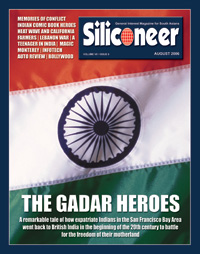
 August is the month of celebrating India’s independence, and Indian Americans will join festivities all over the U.S. with great joy and enthusiasm.
August is the month of celebrating India’s independence, and Indian Americans will join festivities all over the U.S. with great joy and enthusiasm.
 “… Give me your tired, your poor, Your huddled masses yearning to breathe free/ The wretched refuse of your teeming shore/ Send these homeless, tempest-lost to me/ I lift my lamp besides the golden door!”
“… Give me your tired, your poor, Your huddled masses yearning to breathe free/ The wretched refuse of your teeming shore/ Send these homeless, tempest-lost to me/ I lift my lamp besides the golden door!”

 He may be referred to as a joker politician, some analysts may darkly speculate about his propensity towards corruption and nepotism, but Railway Minister Lalu Prasad Yadav also packs a lot of business sense. Don’t take our word for it. Some of the top management institutes such as Harvard Business School, HEC Management School, France and the prestigious Indian Institutes of Management think so. They have deemed his efforts as minister as fit for a case study by upcoming global managers.
He may be referred to as a joker politician, some analysts may darkly speculate about his propensity towards corruption and nepotism, but Railway Minister Lalu Prasad Yadav also packs a lot of business sense. Don’t take our word for it. Some of the top management institutes such as Harvard Business School, HEC Management School, France and the prestigious Indian Institutes of Management think so. They have deemed his efforts as minister as fit for a case study by upcoming global managers.  Landmark Case | A Voice of Reason, Intellect, Muslims and Pakistanis | Bureaucrat Honored | South Asian Heart Center Opens | House Okays Nuke Deal | Hindi Classes in New Jersey High Schools | Sikh Stabbed in Hate Crime | Rajender Reddy Health Center at UC Merced | Pew Scholar | Moonda Murder
Landmark Case | A Voice of Reason, Intellect, Muslims and Pakistanis | Bureaucrat Honored | South Asian Heart Center Opens | House Okays Nuke Deal | Hindi Classes in New Jersey High Schools | Sikh Stabbed in Hate Crime | Rajender Reddy Health Center at UC Merced | Pew Scholar | Moonda Murder An Indian American lawyer has won a landmark victory after the U.S. Supreme Court struck down the military commissions President Bush established to try suspected members of al-Qaida. The ruling, seen as a blow to the administration, came in Hamdan v. Rumsfeld, a case brought to the court by Georgetown law professor Neal Katyal for his client, Salim Ahmed Hamdan, a former aide to Osama bin Laden.
An Indian American lawyer has won a landmark victory after the U.S. Supreme Court struck down the military commissions President Bush established to try suspected members of al-Qaida. The ruling, seen as a blow to the administration, came in Hamdan v. Rumsfeld, a case brought to the court by Georgetown law professor Neal Katyal for his client, Salim Ahmed Hamdan, a former aide to Osama bin Laden. One of the leading voices of reason, intellect, Muslims and Pakistanis here in the San Francisco Bay Area, Professor Syed Hasan Jahangir Hamdani passed away July 28. His funeral was held the following day at the Rolling Hills Cemetery, 4100 Hilltop Drive in El Sobrante. Professor Hamdani was 66 years of age. He had been hospitalized for several days, and reportedly died of heart and lung problems and kidney failure.
One of the leading voices of reason, intellect, Muslims and Pakistanis here in the San Francisco Bay Area, Professor Syed Hasan Jahangir Hamdani passed away July 28. His funeral was held the following day at the Rolling Hills Cemetery, 4100 Hilltop Drive in El Sobrante. Professor Hamdani was 66 years of age. He had been hospitalized for several days, and reportedly died of heart and lung problems and kidney failure.